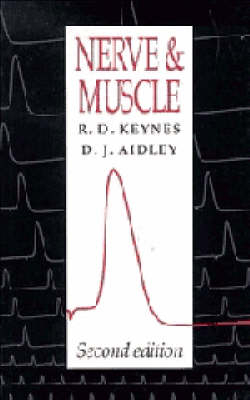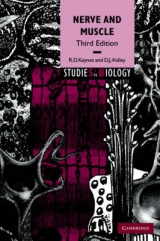
Nerve and Muscle
Seiten
1991
|
2nd Revised edition
Cambridge University Press (Verlag)
978-0-521-42255-0 (ISBN)
Cambridge University Press (Verlag)
978-0-521-42255-0 (ISBN)
- Titel erscheint in neuer Auflage
- Artikel merken
Zu diesem Artikel existiert eine Nachauflage
A textbook for undergraduates taking physiology or cell biology and also for pre-clinical medical students. It provides an account of the basic anatomy and physiology of nerve and muscle tissue, concentrating fully on the presentation of the experimental evidence in support of the conclusions.
Nerve and Muscle is an introductory textbook for students taking university courses in physiology, cell biology or preclinical medicine. The first edition was highly acclaimed as a readable and concise account of how nerves and muscles work. The book begins with a discussion of the nature of nerve impulses. These electrical events can be understood in terms of the flow of ions through molecular channels in the nerve cell membrane. Then the view changes to consideration of synaptic transmission: cell or muscle fibre with which it makes contact. Again ionic channels are involved, but now they are opened by special chemicals released from the nerve cell terminals. The final chapters discuss the nature of muscular contraction, including especially the relations between cellular structure and contractile function. This new edition includes much new material, especially on the molecular nature and characteristics of single ionic channels, while retaining a straightforward exposition of the fundamentals of the subject.
Nerve and Muscle is an introductory textbook for students taking university courses in physiology, cell biology or preclinical medicine. The first edition was highly acclaimed as a readable and concise account of how nerves and muscles work. The book begins with a discussion of the nature of nerve impulses. These electrical events can be understood in terms of the flow of ions through molecular channels in the nerve cell membrane. Then the view changes to consideration of synaptic transmission: cell or muscle fibre with which it makes contact. Again ionic channels are involved, but now they are opened by special chemicals released from the nerve cell terminals. The final chapters discuss the nature of muscular contraction, including especially the relations between cellular structure and contractile function. This new edition includes much new material, especially on the molecular nature and characteristics of single ionic channels, while retaining a straightforward exposition of the fundamentals of the subject.
Preface; 1. Structural organisation of the nervous system; 2. Resting and action potentials; 3. The ionic permeability of the nerve membrane; 4. Membrane permeability changes during excitation; 5. The molecular structure and functioning of voltage-gated ionic channels; 6. Cable theory and saltatory conduction; 7. Neuromuscular transmission; 8. Synaptic transmission in the nervous system; 9. Skeletal muscles; 10. The mechanism of contraction in skeletal muscles; 11. Non-skeletal muscles; References and suggestions for further reading; Index.
| Erscheint lt. Verlag | 21.11.1991 |
|---|---|
| Zusatzinfo | Worked examples or Exercises |
| Verlagsort | Cambridge |
| Sprache | englisch |
| Maße | 139 x 217 mm |
| Gewicht | 260 g |
| Themenwelt | Studium ► 1. Studienabschnitt (Vorklinik) ► Physiologie |
| Naturwissenschaften ► Biologie ► Zoologie | |
| ISBN-10 | 0-521-42255-8 / 0521422558 |
| ISBN-13 | 978-0-521-42255-0 / 9780521422550 |
| Zustand | Neuware |
| Haben Sie eine Frage zum Produkt? |
Mehr entdecken
aus dem Bereich
aus dem Bereich



